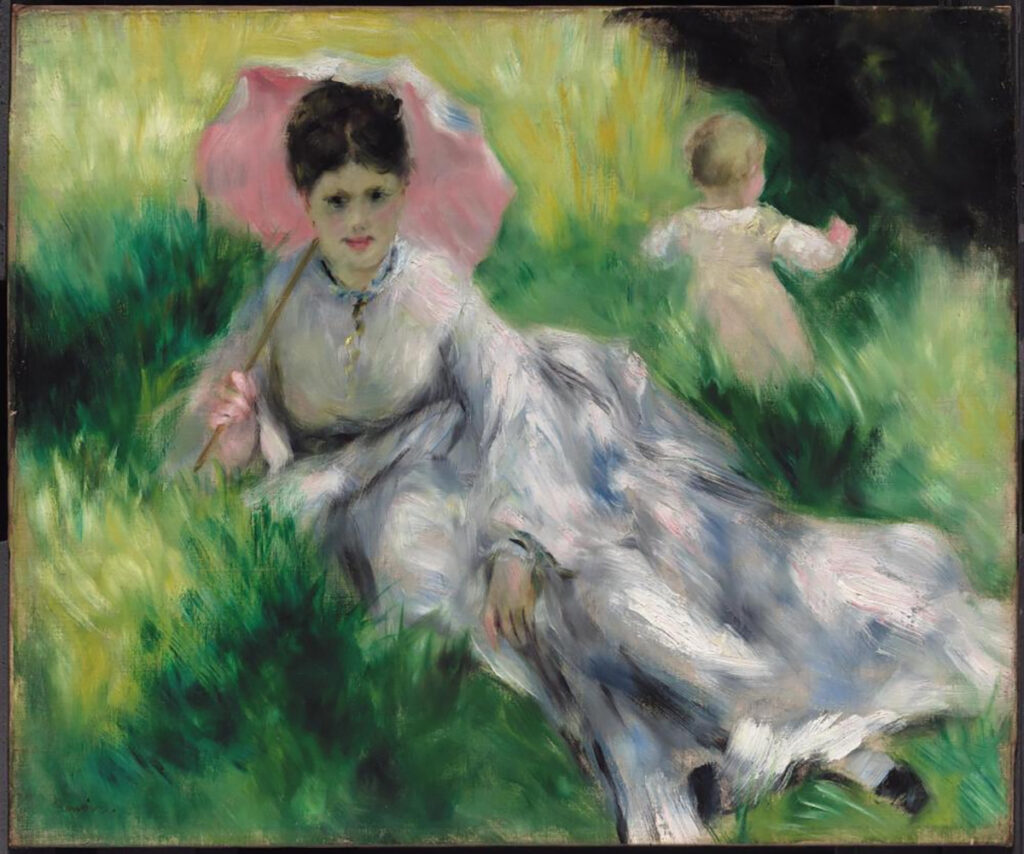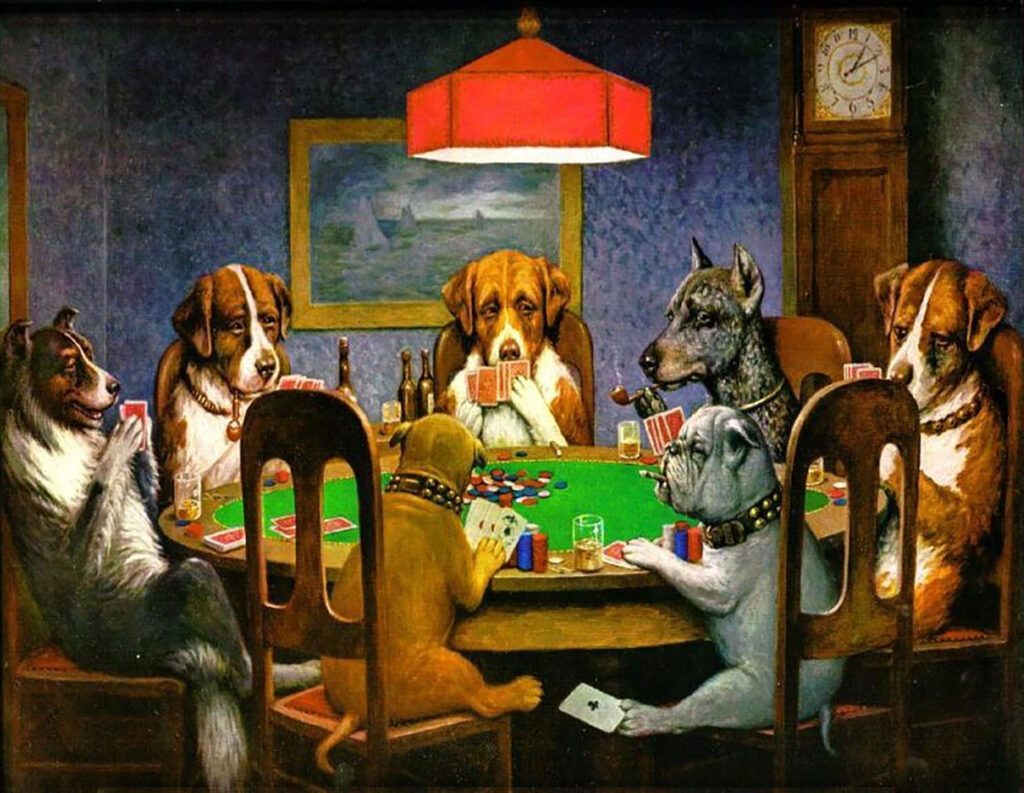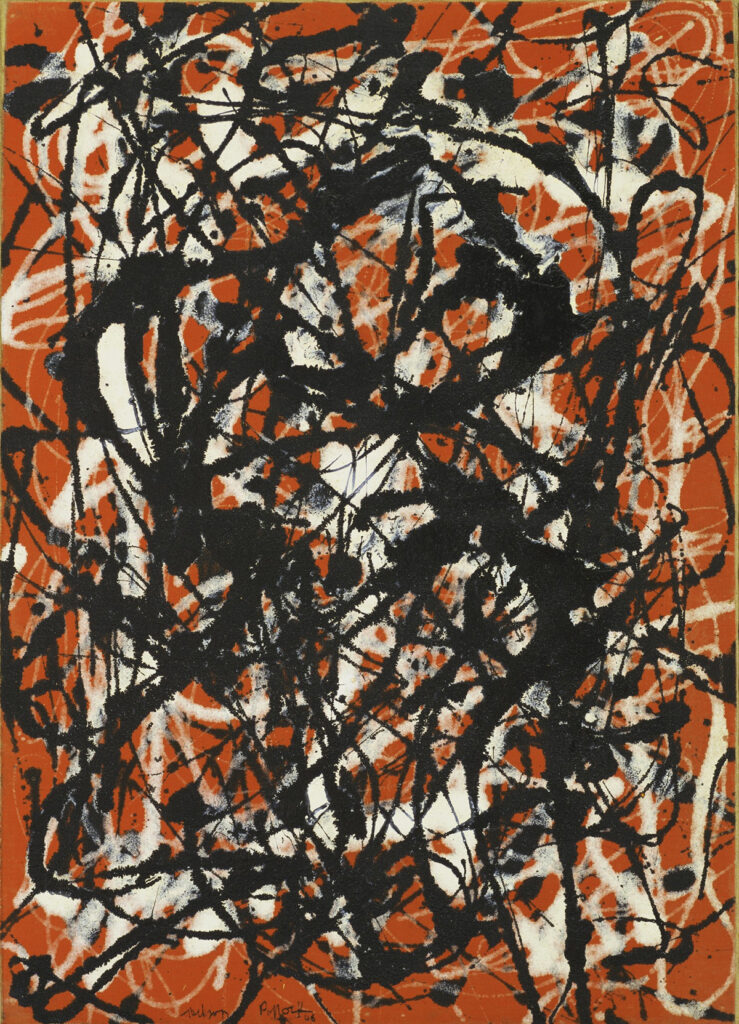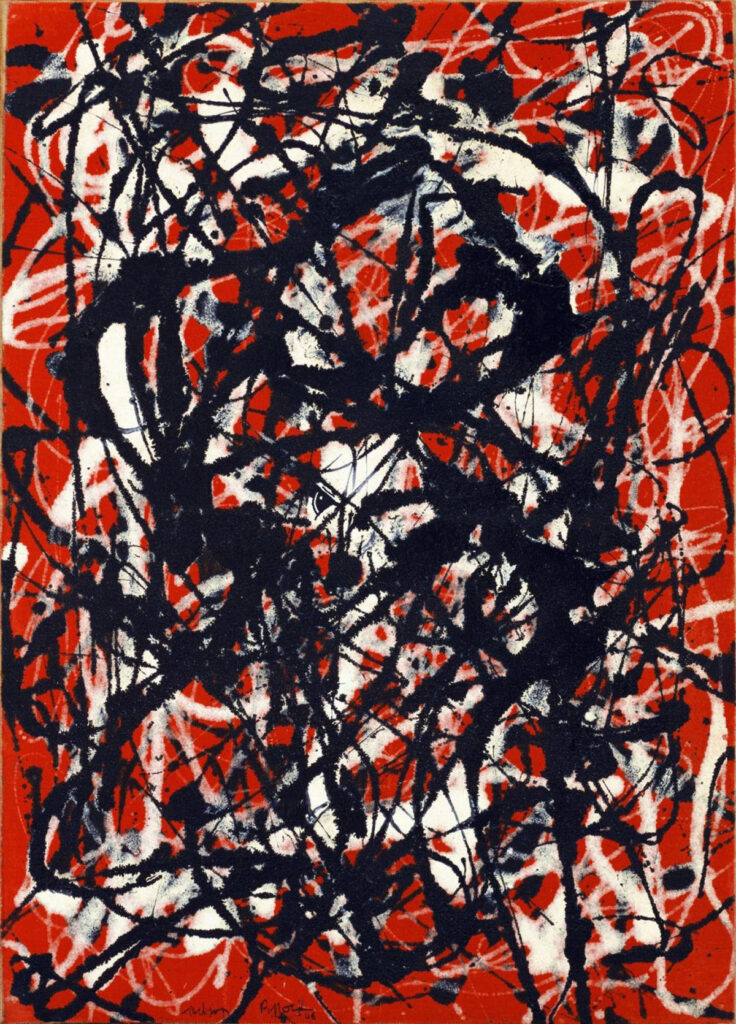How Much Is A Pollock Painting Worth
The Auditor is a 2016 activity thriller starring Ben Affleck, Anna Kendrick and J. K. Simmons, and is directed by Gavin O'Connor. It centers on the grapheme of Christian Wolff, a man who has high-functioning autism. He also happens to be a mortiferous assassin equally well as a vivid auditor. Sounds like fun right? It certainly is! Wolff accepts payment in goods also as cash, which sometimes extends to fine fine art. Paintings in the movie The Accountant include Woman with a Parasol and Modest Child on a Sunlit Hillside by Pierre-Auguste Renoir, Gratuitous Form by Jackson Pollock and A Friend in Need by Cassius Coolidge. All three paintings have enormous real-world fiscal value, only inside the context of the picture show their value is as well symbolic.
Woman with a Parasol by Pierre-Auguste Renoir

Pierre-Auguste Renoir (1841–1919) was a founding fellow member of the Impressionist movement in France during the latter half of the nineteenth century. Impressionists sought to find ways of expressing their subjects through quick, intuitive painting techniques and loose compositions. They moved abroad from the tight, classical studio-finished conventions of the day and experimented with new techniques. Often they would paint in situ in lodge to capture the fleeting qualities of the calorie-free and move that they saw. They sometimes finished the work in 1 sitting, leaving it with an unpolished look. This was radical and against all the traditional rules of art!
Scenes from a play
Renoir liked to try to capture everyday life, with emphasis on the people living it. Oftentimes the setting was a stage for this more important business organization. His paintings are like soft focus photography: they are sensual, soft and flattering. His paintings of social gatherings depict the multifariousness of people and activities that tin occur in just a few moments in time. Renoir wanted to capture that item kind of humming free energy.
Although he started out as a pure Impressionist, he gravitated away from this manner and we see in his later works a more thoughtful, precise, and unhurried execution rather than a spontaneous and dynamic one. That said, in the painting featured here, completed before his modify of approach, we can see that his style is still more controlled than that of his Impressionist contemporaries.
"This in a higher place all: to thine own self be truthful"
Some would say that Renoir had not quite understood the Zeitgeist of being an Impressionist (despite being a founding fellow member). Some too say that it shows a lack of talent, seeing him instead every bit an creative person in the shadow of Monet. I don't recall that this is true. Renoir's style and approach were different from those of Monet, and so why should his paintings be the same? Human interaction is primal for Renoir. His desire to identify it at the center of his work narrowed his focus and therefore demanded a firmer technique.
What is meaningful well-nigh the Renoir?
Worth less than the Pollock simply more than the Coolidge, of the paintings in The Accountant, the Renoir is worth somewhere in the region of $seventy million. To understand its value every bit office of the plot a trivial background is necessary.
Wolff was the reason for the family's abandonment by their female parent. She was unable to take his autism, finding that his behavior as well challenging. It fell to the father to bring up a young family. He taught both his sons, but taught Wolff in particular how to navigate through a life that would inevitably be more difficult. In this regard he was successful. In the flick nosotros see that Wolff has specific coping mechanisms that enable him to engage successfully with the existent world. This is how he survives whatever life may throw at him.
Mother & Kid
So why choose the Renoir? This painting depicts a scene of a female parent and child, bathed in the sunshine of summertime. Why not choose a painting of a male figure instead? Specially if it's going to hang just outside his weapons room? Its incongruity is important. Throughout the film Wolff is at odds with his environment. Details like this painting cast against the brutality of a room total of guns serve to highlight this further.
The female parent in the painting is the epitome of the feminine ideal of the fourth dimension. She is soft, relaxed, and happy. She reposes on a hillside in a gentle palette of pale colors: whites, blues, greys, and pinks. Everything about her is womanly, delicate, graceful, and demure. Her kid on the other hand is wandering off behind her, as toddlers do. Is she aware of this? Her eyes await away rather than out to meet the artist'southward gaze. Is this a moment of heedless on a hot day, or does her subtle grinning suggest that she is listening intently for the audio of her adventuring child?
Wolff's female parent was non ideal, at to the lowest degree not for him, and we see a kid wandering away from its female parent in this painting. Nosotros know that it would exist lost if left unattended. Wolff, even so, was not lost. He had a strong father and a blood brother who loved him. In this respect the Renoir is again incongruous: in reality it was the mother who wandered away and was lost. Wolff in plough became a paragon of composure.
Credence
Wolff might see the Renoir just every bit a painting, or maybe as something more than. I thought that information technology might signify acceptance of his mother's actions. In that location is a sense that the woman in the picture might represent the delectation that she afterward establish. From this standpoint it makes sense that he is able to sell the Renoir, dropping the cost in order to do so. This is a closed chapter in his life. He doesn't need to worry nigh it.
As a symbol of emotional understanding
The Renoir therefore might be a comment on Wolff'southward ability to rationalise strong and deep emotions. Oft information technology is thought, mistakenly, that people with autism don't take emotions. This is simply not truthful. Autistic people nigh certainly do feel, possibly even more than deeply. It is their power to process and manage how they experience that is more challenging. Where nigh of the states empathize our emotions, somebody with autism might need more assist to practice so.
A Friend in Need by Cassius Coolidge

Anthropomorphized animals are zero new (recall Alice in Wonderland'south Cheshire Cat or the Caterpillar). Endowing animals with man qualities never fails to amuse, even if sometimes it's actually weird. We accept great delight in seeing ourselves laid blank in this way. Information technology's close plenty to strike a chord, but removed enough to be amusing. We don't end up taking ourselves – or the art – too seriously. We're comfortably challenged considering we can have a laugh most it.
It is indeed the humorous aspect of these paintings that makes them and so popular. They are attractive because they are funny, which seems to override any denunciation that might be levied at them by the 'serious' critic. This particular painting – A Friend in Need – is only 1 of sixteen from a series called Dogs Playing Poker. It was created after Coolidge signed upwardly to work for the advertising agency Chocolate-brown & Bigelow in 1903. The series was produced every bit part of an advertising campaign for cigars, and calendars containing them establish themselves disseminated beyond America past the thousands.
It'due south okay to like it!
Described as kitsch, is it wrong to appreciate these works as art? Not at all! Very often something becomes more popular because it has a greater universal entreatment. In this case a parody of human behavior makes us express mirth. A Friend in Need is likewise highly accessible: there are no esoteric clues or symbols. There is no mystery and it is down-to-earth. Its humour is capable of reaching everybody, no exclusions. A cynic at this signal would say that equally an advertisement it has, therefore, done its task rather well.
Why is it symbolic?
Wolff refers to A Friend in Demand during a conversation with Dana Cummings (played by Anna Kendrick) in which she confesses that she wanted to go to art college. Her male parent persuaded her to go an auditor instead. She implies that the Dogs Playing Poker series is the kind of art that her father would like. The inference is that information technology is mainstream, pop, and not really 'proper' art.
A highly relatable image
Wolff states "I like Dogs Playing Poker, considering dogs would never bet on things, then it'southward incongruous. I similar incongruity" (Wolff, The Auditor). This incongruity really appeals to his nature as someone who lives his life by logical assessment rather than by taking chances. He sees the irony in the idea put forward by the painting. A Friend in Need presents dogs with human attributes – does Wolff see himself every bit a man with canine ones?
Although A Friend in Need is probably worth a five or even 6 figure sum, it is the least valuable of the paintings featured in The Auditor. It likewise never appears as an original, just only every bit a copy. Its incongruity remains of import equally a plot device: a re-create of it is used to disguise the very much more valuable Jackson Pollock that Wolff gives to Dana at the terminate.
Free Form past Jackson Pollock

Europe before Globe War Ii was the center for art, just after the war this middle shifted to America where dissimilar types of art began to evolve during the following decades. This was in part due to the exodus from Europe of many prominent artists, merely new and radical forms of art had already begun to emerge in Europe during the decades prior to World War Two, for example Constructivism and Surrealism, not to mention developments in motion-picture show and photography, so pushing the boundaries of art was not surprising. There was a need to challenge the formal rules and regulations concerning what defined art.
Lateral Thinking
Jackson Pollock wanted to push the conventional boundaries of painting, especially easel painting. He unsaid that shifts in artistic manner are a direct outcome of a want to observe answers to artistic bug, and that new techniques are a production of this process. He was driven to find a new form and to explore ways of leaving the sometime behind and embracing the new. The idea of the canvas as a self-limiting object was a prominent theme for Pollock: this is the easel painting from which he sought emancipation. He used a flat sail plane in the creation of his nearly famous artworks. Rather than placing them upright, he laid them on the floor, and he did not stretch or prime them. Pollock was able to approach the sail from any management, and therefore exceed the limits of the upright easel format.
Method in Madness
Pollock's method of dripping, pouring, and splattering paint rather than using brushstrokes or a palette pocketknife pulled his form still further away from tradition. Using these methods he applied paint to form many layers of a densely-woven web that seem to exceed the confines of the picture aeroplane. Free Form shows an action that extends beyond the edges: it is most as though the detail that we tin can see is just one modest office of something much greater, perhaps infinite. Among the splatters and drips we find a sense of club: in that location has been no specific provision of line or shape, no figuration, no relative planes except that of the work to the wall upon which it hangs, yet there is a sense of something other than chaos.
Creativitity begets creativity
Pollock's drip paintings prevarication somewhere between existing every bit objects and existing beyond existence objects. Past reason of logic they are still shackled past the dimensions of the canvas itself, but they come about equally close equally possible to transcending it. The fundamental to this is that as observers we are capable of looking across the confines of borders, and nosotros can erase physical edges to go along the patterns for ourselves. I think this is why it's possible to become so entangled in a Pollock: there is countless diversity, and there are endless possibilities for what might happen in the unseen worlds of our imaginations.
Why is the Pollock then of import in The Accountant?
The Pollock in terms of both monetary and personal value is worth the most in The Accountant. Thought to be worth somewhere in the region of $140 meg, it is also the painting that Wolff won't sell. We run across him lying on the bed in his Airstream early in the movie, staring up at the painting which he has mounted on the ceiling. It has a calming effect for him, making us question what it is that he actually sees in information technology. Peradventure he sees method in the convoluted trails of layered paint?
Wolff operates across the usual boundaries in the same fashion that Pollock'due south baste paintings do. At that place is therefore a deep and special connexion between Wolff and this painting. Information technology stands to reason that he sees patterns where others do not, and that this might both delight and fascinate him. He might also be more capable of seeing how these patterns would extend beyond the sheet. This would delight Pollock! Information technology too makes it hugely significant that he later gives it to Dana, hinting that he feels he has a similar relationship to her.
Paintings in the Flick The Accountant: Trivia
Paintings in the movie The Accountant has various fun details, a few of which I'd like to mention here. This is by no ways an exhaustive list!
What's in a name?
- Cassius Marcellus Coolidge was named after the pol and slavery abolitionist Cassius Marcellus Dirt (b. 1810). In 1903 Clay died - the same twelvemonth that A Friend in Need was made.
- Cassius Marcellus Dirt Jr. was the quondam name of Muhammad Ali, the world heavyweight boxing champion. He was named subsequently his begetter, simply Cassius Marcellus Clay Sr. was also named later on the politician mentioned above!
- Cassius Marcellus Coolidge is likewise attributed equally having invented the comic foreground.
Puzzling it out
Paintings in the moving picture The Accountant might also include the jigsaw puzzle seen at the showtime (a immature Wolff is completing it back-to-front). Technically this is a photograph of course, but it is still a significant visual symbol. Information technology is in fact an image of Cassius Clay/Muhammad Ali. He loses the final piece causing him to fly into a panic. A young girl named Justine finds information technology and he then completes the puzzle. We come across it again at the end of the movie, this time the right way effectually and framed as a picture on the wall of Justine's room. It signifies the connection that Wolff and Justine made every bit children, and indicates their lifelong friendship.
I worked out that if y'all calculate the gap between the dates of the artworks, yous get the following: Renoir (1874) to Coolidge (1903) is 29 years, and Coolidge to Pollock (1946) is 43 years. These are both prime numbers. If y'all then add 29 and 43 yous get 72, which is the number of years between the Renoir and the Pollock! This is possibly coincidental, simply suits a film about an accountant.
Just for fun
Cassius Marcellus Coolidge (1844-1934) was born only twelve-or-so years after Lewis Carroll and so was still a very immature human when Alice in Wonderland was published in 1865!
It is interesting that Renoir and Coolidge were born within three years of each other (1841 and 1844 respectively) but that their art couldn't be more different.
The Pollock shown in The Accountant is not the original (although information technology is for the characters). Information technology is identical but for an centre looking out from most to the centre: an add-on made by the moving picture makers.

Picture buff? Read more about paintings on the big screen:
How Much Is A Pollock Painting Worth,
Source: https://www.dailyartmagazine.com/paintings-movie-accountant/
Posted by: smithapphimarly.blogspot.com


0 Response to "How Much Is A Pollock Painting Worth"
Post a Comment